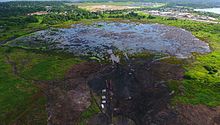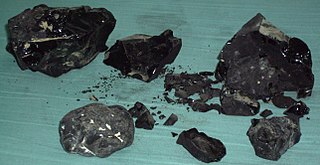
Bitumen is an immensely viscous constituent of petroleum. Depending on its exact composition it can be a sticky, black liquid or an apparently solid mass that behaves as a liquid over very large time scales. In the U.S., the material is commonly referred to as asphalt. Whether found in natural deposits or refined from petroleum, the substance is classed as a pitch. Prior to the 20th century the term asphaltum was in general use. The word derives from the ancient Greek ἄσφαλτος ásphaltos, which referred to natural bitumen or pitch. The largest natural deposit of bitumen in the world is the Pitch Lake of southwest Trinidad, which is estimated to contain 10 million tons.
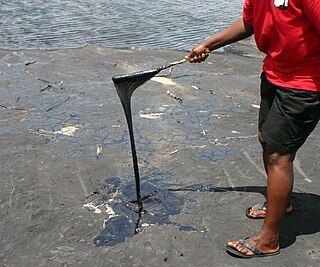
Tar pits, sometimes referred to as asphalt pits, are large asphalt deposits. They form in the presence of petroleum, which is created when decayed organic matter is subjected to pressure underground. If this crude oil seeps upward via fractures, conduits, or porous sedimentary rock layers, it may pool up at the surface. The lighter components of the crude oil evaporate into the atmosphere, leaving behind a black, sticky asphalt. Tar pits are often excavated because they contain large fossil collections.

The La Brea Tar Pits is an active paleontological research site in urban Los Angeles. Hancock Park was formed around a group of tar pits where natural asphalt has seeped up from the ground for tens of thousands of years. Over many centuries, the bones of trapped animals have been preserved. The George C. Page Museum is dedicated to researching the tar pits and displaying specimens from the animals that died there. La Brea Tar Pits is a registered National Natural Landmark.
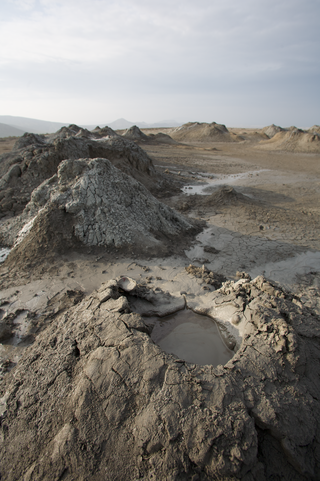
A mud volcano or mud dome is a landform created by the eruption of mud or slurries, water and gases. Several geological processes may cause the formation of mud volcanoes. Mud volcanoes are not true igneous volcanoes as they do not produce lava and are not necessarily driven by magmatic activity. Mud volcanoes may range in size from merely 1 or 2 meters high and 1 or 2 meters wide, to 700 meters high and 10 kilometers wide. Smaller mud exudations are sometimes referred to as mud-pots.
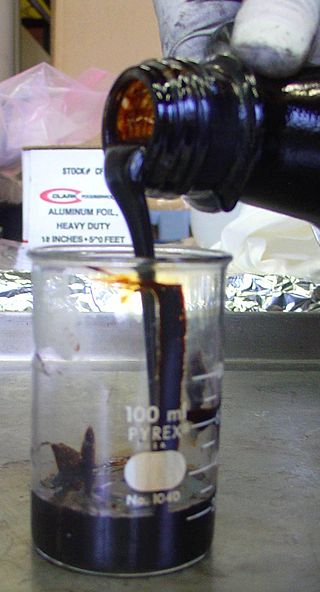
Tar is a dark brown or black viscous liquid of hydrocarbons and free carbon, obtained from a wide variety of organic materials through destructive distillation. Tar can be produced from coal, wood, petroleum, or peat.

Albertite is a variety of asphalt found in the Albert Formation in Albert County, New Brunswick, and in a deposit at Dingwall, in the north-east of Scotland. It is a type of solid hydrocarbon.

La Brea is a town in southwestern Trinidad, located northeast of Point Fortin and southwest of San Fernando. La Brea is best known as the site of the Pitch Lake, a natural asphalt lake. Pronunciation of "La Brea" differs from that used in the USA at the La Brea Tar Pits in Los Angeles. Trinidadians call this place "La Bray".
Alphonso Philbert Theophilus "Fargo" James, born in Black Rock, Tobago, was a Trinidad and Tobago politician. He was elected to the Legislative Council in 1946. He served in the Legislative Council until 1961 when he was defeated by A. N. R. Robinson. James was known as "Fargo", after a brand of trucks, because of his strength and tendency to crush opponents. He was known as being a proponent of Tobagonian secession from Trinidad and Tobago.

A petroleum seep is a place where natural liquid or gaseous hydrocarbons escape to the Earth's atmosphere and surface, normally under low pressure or flow. Seeps generally occur above either terrestrial or offshore petroleum accumulation structures. The hydrocarbons may escape along geological layers, or across them through fractures and fissures in the rock, or directly from an outcrop of oil-bearing rock.

While the local use of oil goes back many centuries, the modern petroleum industry along with its outputs and modern applications are of a recent origin. Petroleum's status as a key component of politics, society, and technology has its roots in the coal and kerosene industry of the late 19th century. One of the earliest instances of this is the refining of paraffin from crude oil. Abraham Gesner developed a process to refine a liquid fuel from coal, bitumen and oil shale; it burned more cleanly and was cheaper than whale oil. James Young in 1847 noticed a natural petroleum seepage when he distilled a light thin oil suitable for use as lamp oil, at the same time obtaining a thicker oil suitable for lubricating machinery. The world's first refineries and modern oil wells were established in the mid-19th century. While petroleum industries developed in several countries during the nineteenth century, the two giants were the United States and the Russian Empire, specifically that part of it that today forms the territory of independent Azerbaijan. Together, these two countries produced 97% of the world's oil over the course of the nineteenth century.
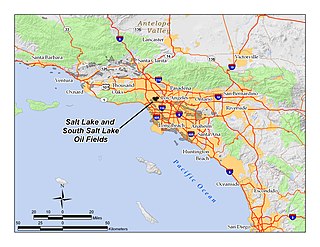
The Salt Lake Oil Field is an oil field underneath the city of Los Angeles, California. Discovered in 1902, and developed quickly in the following years, the Salt Lake field was once the most productive in California; over 50 million barrels of oil have been extracted from it, mostly in the first part of the twentieth century, although modest drilling and extraction from the field using an urban "drilling island" resumed in 1962. As of 2009, the only operator on the field was Plains Exploration & Production (PXP). The field is also notable as being the source, by long-term seepage of crude oil to the ground surface along the 6th Street Fault, of the famous La Brea Tar Pits.

Asphalt volcanoes are a rare variety of submarine volcano (seamount). They were unknown before 2003. Several examples have been found along the coasts of the United States and Mexico and elsewhere, some still showing activity. Asphalt volcanoes resemble other seamounts however they are made entirely of asphalt. The structures are thought to form above geologic faults through which petroleum seeps from deeper in the Earth's crust.

Lake Guanoco is the world's second largest natural tar pit and lies in Venezuela in northern South America.

The McKittrick Tar Pits are a series of natural asphalt lakes situated in the western part of Kern County in southern California. The pits are the most extensive asphalt lakes in the state.

The Carpinteria Tar Pits are a series of natural asphalt lakes situated in the southern part of Santa Barbara County in southern California, US.

Lake Asphalt of Trinidad and Tobago is a company based in La Brea in Trinidad involved in the mining, processing and exporting of asphalt products from the Pitch Lake.

The Binagadi asphalt lake are a cluster of tar pits in urban Baku, Azerbaijan. Asphaltum or tar has seeped up from the ground in this area for tens of thousands of years. The tar is often covered with dust, leaves, or water. Over many centuries, animals that were trapped in the tar were preserved as bones.

The California oil and gas industry has been a major economic and cultural component of the US state of California for over a century. Oil production was a minor factor in the 19th century, with kerosene replacing whale oil and lubricants becoming essential to the machine age. Oil became a major California industry in the 20th century with the discovery on new fields around Los Angeles and the San Joaquin Valley, and the dramatic increase in demand for gasoline to fuel automobiles and trucks. In 1900 California pumped 4 million barrels (640,000 m3), nearly 5% of the national supply. Then came a series of major discoveries, and the state pumped 100 million bbl (16 million m3) in 1914, or 38% of the national supply. In 2012 California produced 197 million bbl (31 million m3) of crude oil, out of the total 2,375 million bbl (378 million m3) of oil produced in the US, representing 8.3% of national production. California drilling operations and oil production are concentrated primarily in Kern County, San Joaquin Valley and the Los Angeles basin.

